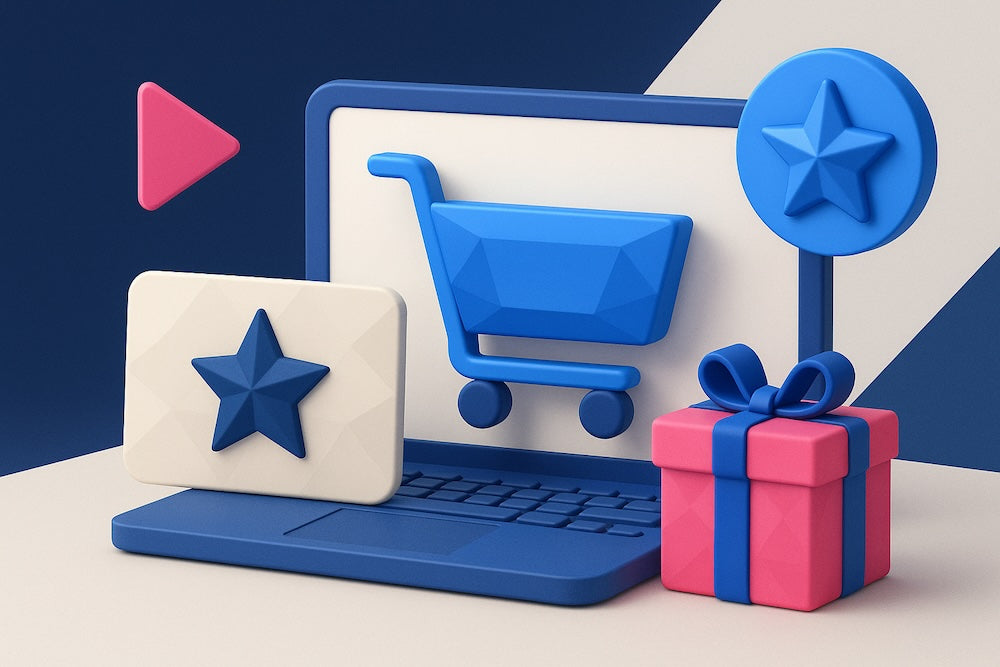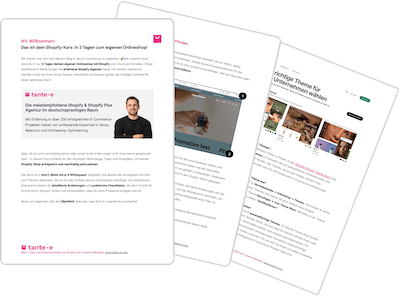Loyalty programs on Shopify are a valuable strategic tool for activating existing customers, increasing customer lifetime value, and personalizing communications. Thanks to the Shopify ecosystem and powerful tools, the possibilities extend far beyond traditional bonus points and loyalty programs.
With the multitude of loyalty apps available on Shopify, the question arises: Where do I start? Which strategy is right for me, and how do I choose the right tools? In this article, we'll give you a practical overview.
We'll examine which Shopify loyalty tools are suitable for which goals and compare three popular solutions: influence.io, Loyalty Lion, and memberrr.

The content of this article is based on the experience of our account manager, Anna. At tante-e, she has already optimized online shops for numerous clients and knows which measures are most effective in practice.
- Reasons for loyalty programs on Shopify
- Which tools are suitable for loyalty programs on Shopify?
- How to strategically build a loyalty program on Shopify
- Best Practices: Integrating Loyalty Programs in Shopify
- Cross-channel communication as a success factor
- KPIs to evaluate your loyalty club on Shopify
- Conclusion
1. Reasons for Loyalty Programs on Shopify
At its core, a loyalty club always pursues the same goal: to encourage existing customers to purchase more frequently and increase their average shopping cart value. For Shopify brands, this can be a relevant lever for achieving sustainable growth, regardless of rising acquisition costs.
The main advantages of loyalty programs are:
- Higher order frequency:
Targeted incentives such as points, rewards or status benefits have been proven to increase customer frequency of purchase. - Increase in shopping cart value:
Mechanics such as minimum order values for rewards or exclusive club offers motivate larger purchases. - More customer data and insights:
Loyalty programs make it possible to collect relevant information directly from the customer account, e.g. on interests, purchasing behavior or decision logic. - Segmentation for personalized communication:
Depending on the points balance or status level, target groups can be targeted, e.g., with upgrades, special offers, or reactivation campaigns. - Stronger brand loyalty:
A well-integrated loyalty club creates a sense of belonging and increases your customers' personal connection to the brand.
1.1. Overview of the goals of a loyalty club
| Objective | How it works in the Shopify store |
|---|---|
| More purchases per customer | Points, rewards and status benefits motivate you to return |
| Higher shopping cart value | Purchase incentives for larger orders and targeted product placements |
| Longer customer relationships | Tiers and club experiences increase emotional bonding |
| Better database | Information on personalization and segmentation |
| More control over retention | Activation via automated flows and targeted campaigns |
With its modular infrastructure, Shopify offers an ideal technical foundation for implementing loyalty programs flexibly and in line with your brand. However, choosing the right solution for your specific goals can be challenging. In the next section, we'll take a closer look at popular tools that have proven successful for loyalty programs on Shopify.
2. Which tools are suitable for loyalty programs on Shopify?
Shopify offers numerous options for integrating loyalty programs into your store. In our experience, three tools in particular have proven their worth: Influence.io, LoyaltyLion, and Memberr.
Whether you're looking for a quick start or a long-term loyalty club strategy, the market offers solutions for a variety of requirements. Three tools have proven particularly successful in practice: Influence.io, LoyaltyLion, and Memberr.
2.1. Loyalty App Comparison: Influence.io, LoyaltyLion and Memberr
| Tool | Target group & use | Strengthen | restrictions |
|---|---|---|---|
| Influence.io | Getting started & quick implementation | Affordable start, easy setup, good basic features | Limited customizability, limited integrations |
| LoyaltyLion | Scaling DTC brands with strategic ambition | Extensive features, many integrations (e.g. Klaviyo, Recharge), deep API | Higher price, no DACH partner network currently |
| Member | Brands with individual loyalty concepts | Flexible setup, German team, innovative use cases | Pricing not transparent, market experience still limited |
2.2. Our recommendations for selection
- For simple loyalty setups with limited resources:
Influence.io is ideal for getting started quickly. Brands like nkm and Rich & Royal use the tool to set up reliable loyalty systems without much lead time. - For data-driven programs with complex requirements:
LoyaltyLion not only offers a wide range of features but also adheres to proven best practices. Combined with tools like Klaviyo or Recharge, it creates an integrated loyalty ecosystem, similar to Hey Marly or buah . - For individual, personally managed loyalty concepts:
Memberr is a specialized provider from Germany with flexible options. The tool is particularly interesting when the focus is on adaptability and collaborative support.
Choosing the right tool not only impacts your technical capabilities, but also your administrative effort and the experience for your customers. In the next step, we'll look at how to strategically build a loyalty program.
3. How to strategically build a loyalty program on Shopify
An effective loyalty program consists not only of a points system but also requires a well-thought-out architecture. Ideally, it combines different incentives, creates a clear structure, and integrates seamlessly into the user experience.
Fundamentally, there are three central elements: points allocation, points redemption and loyalty tiers.
3.1. Point allocation: incentives through rewards
Points are the foundation of many loyalty programs. They create short-term incentives and encourage interaction. It's important that they are used purposefully. They can be used not only for purchases but also for additional options.
Typical triggers:
- Purchases in the shop (based on the order value)
- Account creation (e.g. as a welcome bonus)
- Newsletter or WhatsApp registration
- Addition of profile data (e.g. birthday)
- Product reviews
- Recruiting family members, friends
- Social media interactions (e.g. shares, follows)
- Participation in special promotions or bonus campaigns
3.2. Points redemption: motivation through tangible benefits
For points to be effective, they must be easy to redeem and attractive. The clearer the connection between points and rewards, the higher the redemption rate and thus the higher the customer loyalty.
Possible rewards:
- Discount vouchers with a fixed value
- Cashback (e.g. directly at checkout at Memberr)
- Exclusive products or freebies
- Access to limited promotions or events
- Personalized offers (e.g. birthday vouchers)
It is important that the redemption options fit your brand and are both emotionally and functionally compelling.
3.3. Loyalty Tiers: Long-term commitment through levels
Additional status levels can further motivate particularly active customers. Loyalty tiers are a proven way to reward long-term behavior and build a sense of exclusivity.
Typical animal advantages:
- Free Shipping
- VIP customer service
- Earlier access to new products
- Exclusive content or events
- Individual support or surprises
Tier management can be automated in the Shopify backend using Customer Tags and Shopify Flow. This allows benefits to be automatically activated based on status, such as special discounts at checkout with Shopify Plus or personalized emails when changing tiers.
A strategically designed loyalty program considers all three levels together and combines short-term rewards, long-term motivation and personalized experiences.
4. Best Practices: Integrating Loyalty Programs into Shopify
Loyalty programs should be visible, accessible, and seamlessly integrated into the store. Their placement in the store shouldn't distract customers from making a purchase, but rather provide them with a targeted incentive to sign up and actively use the program. Based on our experience at tante-e, we have compiled the following visibility recommendations:
4.1 Visibility at the relevant places in the shop
| Shop area | Our recommendation for integration |
|---|---|
| navigation | Link to the Loyalty Club as part of the account menu or service area |
| Home | Information area in the lower third of the page with reference to benefits and CTA for registration |
| Product page | Display of collectable points directly below the “Add to cart” button for logged-in users |
| Category page | Restrained use of club banners for special promotions or member sales |
| Account area | Overview of points, status levels, rewards as well as help and FAQs about the loyalty program |
| Landing page | Dedicated page with benefits, tiers, redemption options, call-to-action, and legal information |
| Shopping cart page | No placement – focus remains on the purchase |
| Check out | With Shopify Plus: Redeem points directly in checkout via Checkout UI Extensions |
4.2. Data protection and consent
In the EU, compliance with data protection guidelines is essential, even for loyalty programs. You should consider the following points:
- Checkbox for consent to data processing directly when creating an account
- Customizable wording to explain what data is collected and how it is used
- Clear communication of club benefits associated with registration
4.3 Personalization and user experience
A loyalty program should also match your brand's tone. Personalization helps make the program more relevant and approachable:
- Greeting logged-in users with name and score
- Dynamic content based on status or last action
The technical implementation can be done using existing Loyalty Tools widgets or through individual customizations.
5. Cross-channel communication as a success factor
A loyalty program thrives on visibility and relevance within the store itself and beyond. It's crucial that customers are regularly and specifically reminded of the program. A successful loyalty club strategy therefore considers all relevant channels and leverages existing communication channels to systematically integrate the program. We recommend the following touchpoints:
5.1 Email
Tools like Klaviyo allow you to integrate loyalty elements into the customer lifecycle in a targeted manner. Automated flows that react to status changes or interactions are particularly effective:
- Welcome email upon account creation with an overview of points and benefits
- Post-purchase flows with points balance and redemption recommendations
- Tier upgrade messages with congratulations and an overview of new features
- Reminder for inactive users with bonus promotions or rewards
- Refer-a-friend flows with personal referral links and points for both sides
5.2. Messenger & Retention Channels
Messenger channels such as WhatsApp or SMS offer direct, attention-grabbing contact points:
- Reminders of redeemed or soon-to-expire points
- Exclusive member sales with limited access
- Birthday promotions or personalized offers
These channels require an active opt-in, but offer high open rates and immediate responses.
5.3. Print & Inserts
Physical touchpoints can also be used to activate loyalty, which can be particularly relevant for products that require explanation:
- Package insert with QR code for club registration
- Postcards with benefits for existing customers
- Vouchers for additional points on your next purchase
These measures complement the digital journey and increase the emotional connection to the brand.
6. KPIs: How successful is your Shopify loyalty program?
How can you assess whether your loyalty program is having a lasting impact? Clear metrics and a structured approach help with this assessment. We recommend keeping an eye on the following KPIs:
Relevant KPIs at a glance
| Key figure | Importance for your loyalty program |
|---|---|
| Average shopping cart | Comparison between members and non-members |
| Order frequency | How often loyalty members buy within a certain period |
| Customer Lifetime Value (CLTV) | Total customer value over the duration of the relationship |
| Registration rate | Percentage of shop visitors who create a customer account with club access |
| Points redemption rate | Ratio of points awarded to points actually used |
| Data quality/depth | Scope and relevance of the customer data collected |
Our tip: Be sure to keep an eye on your costs and resources. A loyalty program incurs ongoing costs, which you should consider in relation to the expected effects:
- Tool licenses and setup costs, if applicable
- Time spent on maintenance, updates, content creation
- Cost of goods for rewards
- Communication effort (e.g. email flows, print materials)
We also recommend regularly reviewing reporting dashboards within the loyalty tool itself and via interfaces to systems like Klaviyo or Google Analytics. Only by consistently measuring KPIs can you target specific metrics: Which rewards work? Where do users drop off? Which channel engages particularly well? The answers to these questions form the basis for further developing a loyalty program.
7. Conclusion: How to make your loyalty program a success
Finally, we'll summarize the success factors we've found to be crucial for loyalty programs on Shopify:
- Define goals: Do I want to increase repeat purchases, gain more data, or strengthen customer loyalty?
- Choose the right tool: Influence.io, LoyaltyLion, and Memberr cover different requirements (from intuitive entry to high personalization)
- Plan the structure carefully: Point allocation, rewards, and tiers should be sensibly integrated.
- Implement integration visibly: Your loyalty program does not belong in the background, but centrally linked in the menu, product pages, account area and landing pages
- Actively shape communication: Email, WhatsApp, handouts, and customer support help bring the program to life.
- Measure and manage success: Thanks to KPIs, you know how to specifically optimize and expand your loyalty program.


